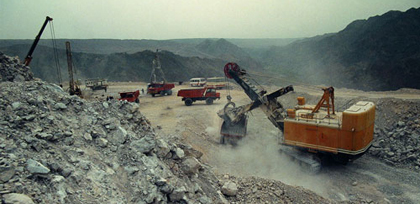
They said the party was over, but Australia's giant resources sector is surging into a two-horse race between iron ore and coal, with the latest numbers revealing that there is still fire in the belly of the boom, thanks mainly to sustained growth in China.
A key resources index showed that the resource-rich island nation will reap over $21 billion from iron ore exports in the last quarter of 2013, suddenly outstripping the export revenues of coal by more than double.
The latest East & Partners' iron ore and coal index released this week revealed that falling thermal and coking coal revenues ( hitting $10.1 billion in Q4 2013) belie a solid rise in exports and continued interest from shrewd Chinese players.
Based largely on industry collations and state government data, the report estimates 151.5 million tons of iron ore was exported in Q4 2013, a leap of 20.9 percent on volume in the previous corresponding period.
And while iron ore prices win the big profits, coal could be the turtle to the hare in a race that is as much about distance as speed.
The welcome news comes as several Australian coal juniors look set to lead a long-term revival under the tutelage of Chinese energy giants looking for durable partners with a five-to-ten year outlook full of stamina.
This week, China Kingho Energy sweetened its already generous $71.2 million play for Bowen Basin based Carabella Resources.
Chinese enterprises with solid backing and experience are looking further afield and have traditionally taken a long-term view of coal opportunities with viable projects down the line.
Kingho brings an interest in metallurgical coal and Carabella is one of the few listed ASX coal "juniors" with solid exposure, through its Grosvenor West project, to attractive hard-coking coal.
Enthusiasm for Chinese led integration and investment is growing across the sector, particularly among coal juniors looking for partners to expedite technological conversion.
Michael Johnson, director of QE Innovations, a coal and mining technology outfit, based in the coal rich regions of NSW, told Xinhua that the industry in Australia is now at an optimal setting.
"The investment in Australian coal is timely and terrific news for the sector," Johnson said.
"Coal may be lagging behind its big brother (iron ore) for the moment, but it has played such a key part of Australia's historical economy, that we can safely say this is the one resource with genuine staying power."
Certainly, mining giant BHP Billiton (Mitsubishi Alliance) extracted 45 million tons of coal from just the Bowen Basin in the last financial year.
And, according to QE Innovations it is chewing on an expected further by 15 million tons in the 2013-14 financial year.
Yet, while the volume of coal shipments has been up, the weaker lower are expected to put a strain on revenue, opening up opportunity for buyers, with the shrewd cartels out of China, expected to capitalize.
Thermal coal shipments are reported to have risen 3.1 percent to 50.1 million tons but revenue has fallen half a percent to $4 billion.
Australia has $26 billion in advanced coal mining projects and associated infrastructure, involving more than 74 million additional tons of coal production by this year .
"Less advanced" coal mine and coal infrastructure projects have a potential capital expenditure of $45 billion, according to the Australian Coal Association (ACA).
New South Wales (NSW) and Queensland remained the main producing states with around 97 percent of Australia's output of black coal, and almost all of Australia's black coal exports.
"It is very encouraging to see this level of long term investment in the market in a period which has been considerably challenging for coal suppliers, contractors and the sector as a whole," he said.
Meanwhile, shares of iron miners have jumped here, following a continually positive perspective on China - Australia's key trading partner and the foundation of the mining boom that has powered Australian growth and seen two trade push past $100 billion in the last few years.
In fact, Johnson argues, it is China's consistent growth, its forward-looking infrastructure projects and the successful urbanization that has allowed coal forecasters to remain bullish and watch supply constraints to guard against instability.
Johnson, who leads a small and diverse group of engineers involved in the design of mining technologies, told Xinhua that black coal mining in Australia has increasingly become world-leading and sophisticated, high-tech activity.
"The coal industry here is supported by a strong equipment and services sector. Australia has world-class expertise in design, construction and operation of mines, transport systems and loading facilities. It also has expertise in training, technical support and project management."
The mining investment boom curtain was supposed to have fallen last year but export earnings and the contribution to public revenue are not declining as iron ore, coal and other observers have noted according to East & Partners' iron ore and coal (IOC) index.
Should the energy giant go ahead, Kingho's maiden investment in Australia reflects a traditionally long-term outlook which will subsequently allow the group to diversify its resource base with a reportedly itchy checkbook of just under $1 billion to go shopping with.
An investment pattern with very Chinese characteristics that QE Innovations believes may yet add some bang, to a familiar boom.





